Southern California residents brace for 'big one' after twin quakes, but experts say chances are low
Experts say quakes in Ridgecrest are a wake-up call to be prepared.
After a pair of earthquakes in Southern California, residents are bracing for the worst.
By Monday afternoon, the SOS Survival Store in Van Nuys was sold out of earthquake emergency kits, and business owner Jeff Edelstein was adding customers to a two-week wait list for a basic package containing a three-day supply of non-perishable food and water, flashlights and a first-aid essentials to endure the aftermath of major temblor.
The run on Edelstein's Southern California store started after a 6.4 magnitude quake struck the town of Ridgecrest, more than 100 miles northeast of Van Nuys. The Independence Day shaker was followed by one a day later that measured a magnitude of 7.1.
"It's been 20 years since we had this large of an earthquake," Edelstein said. "A lot of people are panic buying, which tends to happen after earthquakes. They're seeing it on the news, they're seeing it everywhere. They're afraid something is going to happen."

The twin holiday weekend earthquakes sent a double jolt reportedly felt from Los Angeles to the San Francisco Bay Area, but earthquake experts said it's highly unlikely the spike in seismic activity is an omen of the "big one," the natural catastrophe for which Californians have long been bracing.
Following the back-to-back shakers in the sparsely populated area of Kern County in the Mojave Desert, some seismologists worried that the movement of the tectonic plates could apply pressure to the San Andreas fault, the famed fissure that runs the length of California's coast and produced a 6.6 magnitude quake that hammered urban areas of Los Angeles County in 1971, killing 64 people and injuring more than 2,500.
The last major earthquake to hit Southern California was the magnitude of 7.1 Hector Mine shaker on the Lavic Lake fault near Barstow, about 80 miles south of Ridgecrest. But that earthquake also happened in a remote area of the Mojave and caused little damage and no injuries.
In contrast, the 6.7 magnitude Northridge shaker in 1994 killed more than 50 people and caused in excess of $40 billion in damage. The Northridge quake occurred on a previously unknown fault 9 miles underground.

"The rule of thumb is about a 5% chance of something bigger happening in the week after. That probability will decrease with time. But it's certainly not a prelude to a large event on the San Andreas that could be even bigger," Ole Kaven, a geophysicist at the U.S. Geological Survey's Earthquake Science Center in Menlo Park, California, told ABC News.
"The San Andreas is quite a ways away. So it's very unlikely that these events will have any direct effect on the seismicity or increased hazard of seismicity on the San Andreas itself," Kaven said.
The Ridgecrest quakes happened in the Airport Lake Fault zone, which runs roughly 50 miles through the Mojave desert and is about 180 miles from the San Andreas fault, Kaven said. The quakes occurred on perpendicular fissures in the zone, including one that had not been previously charted.

The first quake on Thursday was a foreshock to the larger jolt that shook the region on Friday, according to the USGS. Since then, there has been a series of aftershocks, including five measuring 5 to 5.4 on the Richter magnitude scale. At least one magnitude 3 aftershock rattled the area on Monday morning, according to the USGS.
The two largest quakes occurred 8 to 10 miles underground and caused relatively minor damage and very few injuries.
During a packed town hall meeting in Ridgecrest on Sunday afternoon, Capt. Anthony Romero of the Kern County Fire Department told those in attendance that while Thursday's quake "opened up the eyes of this community," Friday's quake "terrified the community."
Ridgecrest Police Chief Jed McLaughlin said during the town hall meeting that a damage assessment was still being conducted and noted that many residents are so frightened to go back into their homes that they've been sleeping in their front yards.
"Look, I'm glad you thought it was safe to be able to sleep out in your front yard, to sleep in your cars. That makes me feel good that you had your faith in us that you could do that, but now I need you to get back in your house," said McLaughlin. "It is time for recovery."
Kaven said earthquakes aren't rare in the Ridgecrest area. He said a 5.8 quake occurred there in 1995.
The most powerful recorded earthquake to rock the area was a magnitude 7.5 in 1872.
Besides the fact that there were major earthquakes on consecutive days, last week's Ridgecrest shakers were "very typical California earthquakes," Kaven said.
"The magnitude, the depth, the type of shaking that was experienced at the surface was very akin to what other earthquakes have been and felt like," he said. "So, it's a very good reminder that most Californians live in earthquake country and that we need to be prepared for this type of event and safeguard our homes and workplaces and so on."




